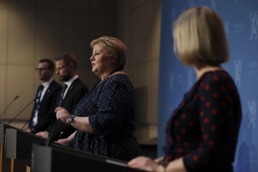Are we sure we really know what a crisis is?
-
Sist oppdatert
22. november 2024
-
Kategori
How to communicate fact-based information more effectively during the next prolonged crises.
SCIENCE NEWS FROM KRISTIANIA: Risk communication
We all know what a crisis is, right? Something that happens quite suddenly and often without much warning. This thinking is in line with most academic research that defines crises as events. They might be untimely and range in their severity from low to high, but they are typically assumed to be punctuated events that can be described in a well-structured crisis lifecycle.
This lifecycle includes pre-crisis opportunities for risk management, a trigger that causes the event, the short-term crisis event itself, and then the longer road to recovery and renewal.
Certainly, this is exactly what a crisis is…except when it is not.
There are many crises that do not fit neatly into this lifecycle, like the climate crisis, COVID-19, or ongoing conflicts. In fact, these other crises have been called more names than Kanye West; disasters, wicked problems, super wicked problems, societal level crises, novel crises, or ongoing crises.
When we think beyond the single event, we begin to realize that complex longer-term crises are not new occurrences; in fact, the typical conceptualization of crises as reflecting isolated periods of time has been problematized for more than a decade.
While these prolonged crises may have many of the properties commonly associated with crises, we assert they are distinctive, meaning that we cannot think, act, or respond in the same way. Therefore, it is important to:
1. Define prolonged crises as a novel type of crisis or hazard
2. Compare events to prolonged crises
Ripples, waves, and riptides as crisis metaphor
So, how should we describe these bigger, more challenging, and certainly more complex crises? What are their core characteristics?
Let us start with a shameless metaphor. When a bird swims across what looks to be a calm sea, it is not clear what is underneath, what the ripples in the water are – a bit of wind, a strong current, or whether there is a shark about to attack from below – because water can be deceptive to look at.
More effective organizations prepare for these ripples, assuming that it might be more than the wind.
There is uncertainty with the ripple – or the risks that practitioners have to manage. But generally, more practitioners are used to managing the day-to-day reputational crises connected to social media rumors, complaints, and the like.
The wave, however, is clearly understood – the bigger the wave the bigger and more powerful the break. Thinking about a wave as an event-driven crisis, there is a starting point. Practitioners and academics in the field of risk and crisis communication are used to looking for the signs of the big crises or tsunami-sized ones caused by major transgressions or organizational events by using risk management or issues management approaches to manage the risks.
Although the fields of risk and crisis communication/management clearly conceptualize the wave of crisis, one thing made clear from the COVID-19 pandemic, is the lack of conceptual development surrounding prolonged crises.
There is an insufficient understanding of the riptide; where the water may look calm, but when people venture into it, the strength of the tide can threaten their lives.
One of the features distinguishing ripples, waves, and riptides is their durable nature. Ripples and waves are temporary no matter the size of their effects. Riptides tend to be persistent.
While beach development often steers people towards the risk, more effective beach management can reduce the risk. The riptide is a strong metaphor for the prolonged crisis because prolonged crises are not temporary abnormalities, they are not episodic, and they cannot be defined as a passing moment of chaos. But the risk they pose can be managed.
Riptide of crises:
- Durable or persistent crises creating risk or harm at the societal level.
- They can emerge across multiple geographic locations.
- Contribute to or trigger multiple event crises
- Coincide with ‘infodemics’ related to the issue
- (Inevitably) produce crisis fatigue
- Lead to a variety of changes to attitudes, policy, strategic alliances, social, work-related practices, institutions.
Most blame is likely to be assigned not for the cause of the crisis but for the response to the crisis. However, blame attributed for the cause will most likely be based on politicalization and mitigating responsibility (e.g., scapegoating others).
Comparing event crises to prolonged crises
Most crises can be described based on six characteristics:
- Time
- Impact
- Geography
- Information management
- Change likelihood
- Blame attribution
While all crises will have similar central concerns and questions, the nature of those questions will change depending on crisis type. In focusing on these six crisis characteristics, we can see some of the clear differences between event crises and prolonged crises (see Figure 1).

Fact-based versus fear-based messages
Effective information management is important during all crises. During prolonged crises it is essential that governments and other organizations successfully disseminate fact-based and relevant information. That way they can mitigate the risks as much as possible and ensure support or compliance with recommendations and rules.
Infodemics are caused by both a public misunderstanding of science as well as a contested space of information. During prolonged crises, bad-will actors also use highly emotional messaging – especially fear-based messaging – to mislead citizens about issues and policies.
An event can mobilize action because fear is still manageable. In the prolonged crisis, the fear can become debilitating. Institutions that use fear-based messaging to respond to a prolonged crisis are likely to demotivate people from enacting self-protective behaviors.
What organizations are blamed for in prolonged crises
The question of blame in the context of a prolonged crisis is different from most event-based crises because the question of ‘who is to blame’ for the crisis is simply less relevant. This makes questions of blame potential more like disaster events. Blame considerations in prolonged crises center on the (in)effectiveness and (in)action of organizational response rather than on the cause of the event crisis. More importantly, organizations – especially governments – are more likely to be viewed harshly for failing to take action to mitigate the impact either through poor preparation or poor response.

Read more:
The new normal with prolonged crises
Shifting our thinking about the role of fear is only the tip of the iceberg. It is well-recognized that in the wake of event crises organizations must often change to reduce risk, to avoid making the same mistake again, or to even build its crisis capacity. During and after prolonged crises, this may still be true, but the nature of prolonged crises means that there is likely a new status quo – a new normal.
For example, post-COVID, the ways that many can and do prefer to work have changed. As workplaces tried to return to normal, many found it difficult to get people working to pre-pandemic expectations. Why? Because prolonged crises are often associated with fundamental changes to work and consumer behavior routines across individual, organizational, and societal levels.

Les temamagasinet om strategisk kommunikasjon:
Steering with the wheel instead of reinventing it
In the last of the shameless nautical puns, our argument is not that risk and crisis communication needs to start over when it comes to prolonged crises. In its brief history, research in risk and crisis communication has resulted in scores of different types of frameworks being developed and applied. We suggest there is no point in beginning from scratch with theory development and application in the field. We should be thinking of more innovative ways of applying theory to practice and experience.
A contingency approach that focuses on a diagnostic approach to identify the factors most affecting a situation and design response strategy around those factors, might be a more agile and practitioner-friendly approach than relying on new and different frameworks.
The most important guidance suggests that prolonged crises are daunting because of the increasing global interconnectedness of people via travel, media, economic systems, food/agriculture infrastructure, and access to information.
This all means that the communication and engagement realities surrounding prolonged crises, like the COVID-19 pandemic, were unprecedented. Many mistakes were made. However, because of the pandemic, we are better equipped to understand that communication must be prioritized alongside the material crisis response (e.g., medical, emergency response, and/or policy making).
Having the best policy or medical interventions simply do not matter if people do not know about them or are unwilling to follow that guidance. The question really is whether there is the social, cultural, economic, and political will to better prepare for and respond to prolonged crises. That remains the biggest challenge.
Reference:
Diers-Lawson, A., & Omondi, G. (2024 – in press). Ripples, waves, and riptides: Reconceptualizing wicked, novel, and ongoing crises as prolonged crises. In B. Liu and A. Mehta (Eds.), Handbook of Risk, Crisis, and Disaster Communication. Routledge.
Text: Audra Diers-Lawson, Professor, and Grace Omondi, Research Fellow, School of Communication, Leadership and Organization, Kristiania
We love hearing from you!
Send your comments and questions regarding this article by e-mail to kunnskap@kristiania.no.
Siste nytt fra Kunnskap Kristiania
 Kunnskap KristianiaLes mer
Kunnskap KristianiaLes merÅrskavalkaden - våre mest populære artikler i 2025
Hvert år er, strengt tatt, et innholdsrikt år. Likevel føltes 2025 ekstra tettpakket. Kunnskap KristianiaLes mer
Kunnskap KristianiaLes merHva er god utdanning?
I Kunnskap Kristianias nye temautgave har vi invitert forskere og undervisere til å reflektere rundt hvordan vi lærer, og hvordan god utdanning formes. Kunnskap KristianiaLes mer
Kunnskap KristianiaLes merFred for enhver pris?
Kjære Nobelkomité: Det finnes tider da dere ikke bare deler ut en pris, men skriver i verdens moralske grunnbok. Kunnskap KristianiaLes mer
Kunnskap KristianiaLes merShort exchange programmes provide meaningful learning experiences
By participating in an exchange programme, students develop skills such as critical thinking, empathy and intercultural understanding.








